Related Research Articles
The Sundowners is a 1960 Technicolor comedy-drama film that tells the story of a 1920s Australian outback family torn between the father's desires to continue his nomadic sheep-herding ways and the wife and son's desire to settle in one place. The Sundowners was produced and directed by Fred Zinnemann, adapted by Isobel Lennart from Jon Cleary's 1952 novel of the same name, with Deborah Kerr, Robert Mitchum, and Peter Ustinov, Glynis Johns, Mervyn Johns, Dina Merrill, Michael Anderson Jr., and Chips Rafferty.

Jedda, released in the UK as Jedda the Uncivilised, is a 1955 Australian film written, produced and directed by Charles Chauvel. His last film, it is notable for being the first to star two Aboriginal actors, Robert Tudawali and Ngarla Kunoth in the leading roles. It was also the first Australian feature film to be shot in colour.
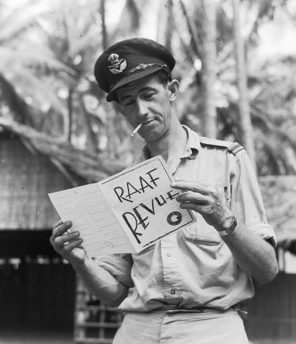
John William Pilbean Goffage MBE, known professionally as Chips Rafferty, was an Australian actor. Called "the living symbol of the typical Australian", Rafferty's career stretched from the late 1930s until he died in 1971, and during this time he performed regularly in major Australian feature films as well as appearing in British and American productions, including The Overlanders and The Sundowners. He appeared in commercials in Britain during the late 1950s, encouraging British emigration to Australia.

Whiplash was a British/Australian television series in the Australian Western genre, produced by the Seven Network, ATV, and ITC Entertainment, and starring Peter Graves. Filmed in 1959-60, the series was first broadcast in the United Kingdom in September 1960, and in Australia in February 1961.
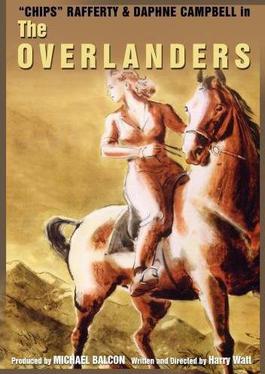
The Overlanders is a 1946 British-Australian Western film about drovers driving a large herd of cattle 1,600 miles overland from Wyndham, Western Australia through the Northern Territory outback of Australia to pastures north of Brisbane, Queensland during World War II.
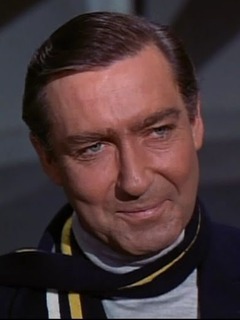
Guy Doleman was a New Zealand born actor, active in Australia, Britain and the United States. He is possibly best remembered for being the first actor to play Number Two in the classic cult series The Prisoner.
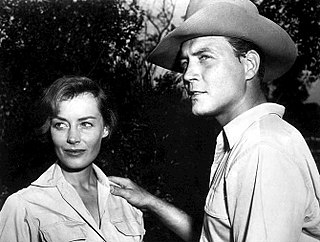
Victoria Shaw was an Australian film and television actress.
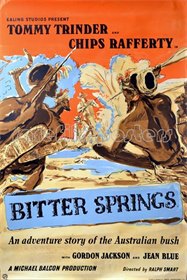
Bitter Springs is a 1950 Australian–British film directed by Ralph Smart. An Australian pioneer family leases a piece of land from the government in the Australian outback in 1900 and hires two inexperienced British men as drovers. Problems with local Aboriginal people arise over the possession of a waterhole. Much of the film was shot on location in the Flinders Ranges in South Australia

Walk Into Paradise is a 1956 French-Australian international co-production adventure film directed by Lee Robinson and Marcello Pagliero and starring Chips Rafferty and Françoise Christophe. It was shot on location in the highlands of Papua New Guinea.
Lee Robinson was an Australian producer, director and screenwriter who was Australia's most prolific filmmaker of the 1950s and part of the creative team that produced the late 1960s international hit television series Skippy the Bush Kangaroo.
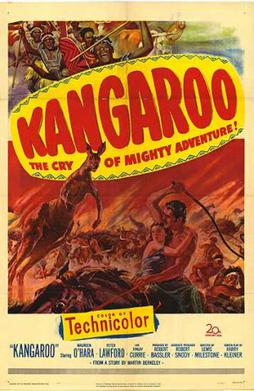
Kangaroo is a 1952 American Western film directed by Lewis Milestone. It was the first Technicolor film filmed on location in Australia. Milestone called it "an underrated picture."
King of the Coral Sea is a 1954 film starring Chips Rafferty and Charles Tingwell, directed by Lee Robinson and shot on location in Thursday Island. It was one of the most commercially successful Australian films of the 1950s and was Rod Taylor's film debut.
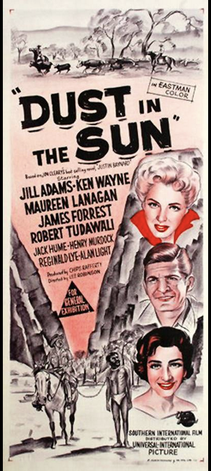
Dust in the Sun is a 1958 Eastmancolor Australian mystery film adapted from the 1955 novel Justin Bayard by Jon Cleary and produced by the team of Lee Robinson and Chips Rafferty. The film stars British actress Jill Adams, Ken Wayne and an Indigenous Australian actor Robert Tudawali as Emu Foot.
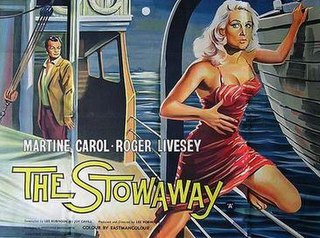
The Stowaway is a 1958 French-Australian film directed by Australian director Lee Robinson and French Lebanese director Ralph Habib. It was shot on location in Tahiti and is one of the few Australian financed movies of the 1950s, although the storyline has nothing to do with Australia.

Australian Western, also known as meat pie Western or kangaroo Western, is a genre of Western-style films or TV series set in the Australian outback or "the bush". Films about bushrangers are included in this genre. Some films categorised as meat-pie or Australian Westerns also fulfil the criteria for other genres, such as drama, revisionist Western, crime or thriller. A sub-genre of the Australian Western, the Northern, has been coined by the makers of High Ground (2020), to describe a film set in the Northern Territory that accurately depicts historical events in a fictionalised form, that has aspects of a thriller.
Double Trouble is a docu-drama directed by Lee Robinson about two Australian men intolerant of foreign migrants who find themselves transported to a foreign country.
Henry Murdoch, born as George Henry Murdock, was an Aboriginal Australian actor and stockman who appeared in Australian films of the 1940s and 1950s. He was working as stockman in Rockhampton when discovered by Ralph Smart, who was helping make The Overlanders (1946). The film's director, Harry Watt, later claimed Murdoch and fellow aboriginal actor Clyde Combo "proved to be first-class actors and were exceedingly quick witted and intelligent. They certainly disproved the conventional idea that the Australian aboriginal is an animalistic caveman." Filmink said "It was Henry Murdoch who personified a specific type of role in the 1940s and 1950s, the aboriginal stockman who was a sidekick/tracker to the white hero."

The Pathway to the Sun is a 1949 novel by Australian author E. V. Timms. It was the second in his Great South Land Saga of historical novels.
Rona Ellen Glynn, also known briefly as Rona Schaber after marriage, was the first Indigenous Australian school teacher and nurse in Alice Springs in the Northern Territory. In 1965 she became the first Aboriginal woman to have a pre-school named in her honour in Australia.
Chips is a 1952 Australian radio drama series starring Chips Rafferty. It is not to be confused with his earlier series The Sundowner although it too was an outback adventure series.
References
- 1 2 3 4 "FEATURES". The Sunday Herald . Sydney: National Library of Australia. 12 July 1953. p. 14. Retrieved 25 August 2012.
- ↑ "The Phantom Stockman". British Film Institute. Archived from the original on 18 January 2009. Retrieved 19 May 2010.
- ↑ Mayer, Geoff. "The Phantom Stockman: Lee Robinson, Chips Rafferty and the Film Industry that Nobody Wanted". Metro Magazine: Media & Education Magazine, No. 142, Autumn 2005: 16-20.
- ↑ "ACTOR CRITICISES RULING ON FILMS". The Sydney Morning Herald . National Library of Australia. 22 January 1952. p. 4. Retrieved 18 March 2015.
- ↑ "Money defence[?] not film". Daily Advertiser . Wagga Wagga, NSW: National Library of Australia. 23 January 1952. p. 2. Retrieved 18 March 2015.
- 1 2 3 4 "KING OF THE CORAL SEA: An Interview with Lee Robinson" by Albert Moran, Continuum:The Australian Journal of Media & Culture vol. 1 no 1 (1987) Australian Film in the 1950s Edited by Tom O’Regan accessed 30 March 2015
- ↑ Vagg, Stephen (24 July 2019). "50 Meat Pie Westerns". Filmink.
- 1 2 3 4 5 Robinson, Lee (15 August 1976). "Lee Robinson" (Oral history). Interviewed by Graham Shirley. National Film and Sound Archive.
- ↑ "Film Shooting Nears Completion". Centralian Advocate (Alice Springs, NT : 1947–1954) . Alice Springs, NT: National Library of Australia. 1 August 1952. p. 1. Retrieved 30 August 2015.
- ↑ "Bouquet For Beauty". The Mercury . Hobart, Tas.: National Library of Australia. 30 June 1952. p. 14. Retrieved 22 March 2012.
- ↑ "VICTORIA SHAW: "I have been true to myself"". The Australian Women's Weekly . National Library of Australia. 11 February 1976. p. 4. Retrieved 25 August 2012.
- ↑ "17-year-old Girl Star of New Film". The Sydney Morning Herald . National Library of Australia. 26 June 1952. p. 11. Retrieved 18 March 2015.
- ↑ "Film Production Underway". Centralian Advocate . Alice Springs, NT: National Library of Australia. 4 July 1952. p. 1. Retrieved 22 March 2012.
- ↑ "Farewell to Keith Price". Centralian Advocate . Alice Springs, NT: National Library of Australia. 11 July 1952. p. 10. Retrieved 22 March 2012.
- ↑ "Inigo Jones and the Rain". Centralian Advocate . Alice Springs, NT: National Library of Australia. 18 July 1952. p. 1. Retrieved 22 March 2012.
- ↑ Vagg, Stephen (25 May 2020). "The A to Z of Non-White Aussie Movies and TV in White Australia". Filmink.
- ↑ "REVIEWS OF NEW FILMS..." The Sunday Herald . Sydney: National Library of Australia. 19 July 1953. p. 15. Retrieved 18 March 2015.
- ↑ "Other 39 -- No Title" Chicago Daily Tribune 21 July 1956: c6.
- ↑ "Alan Bardsley – film and television scripts, 1952, 1959". State Library of New South Wales. Retrieved 19 May 2010.
- ↑ "Film Made By Australian". The West Australian . Perth: National Library of Australia. 25 February 1953. p. 14. Retrieved 18 March 2015.
- ↑ "DEMAND FOR LOCAL FILMS". The Sunday Herald . Sydney: National Library of Australia. 2 August 1953. p. 14. Retrieved 25 August 2012.